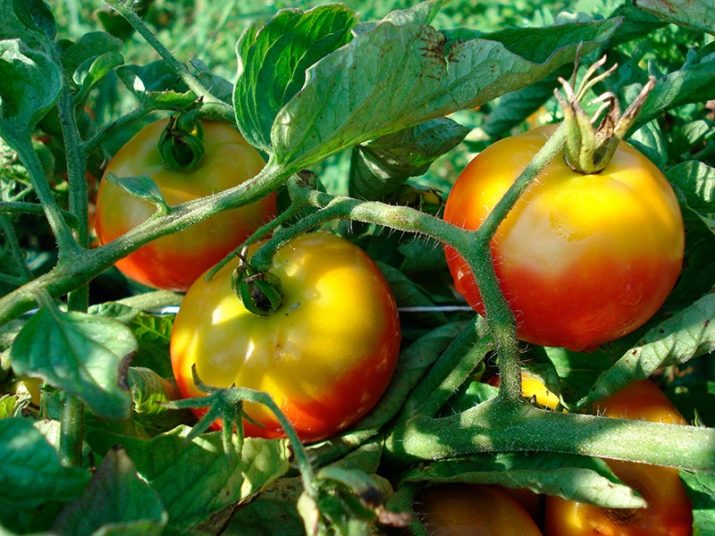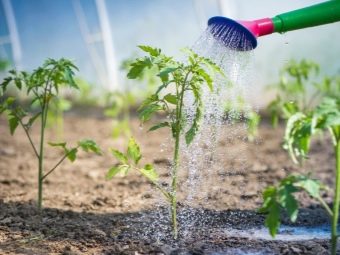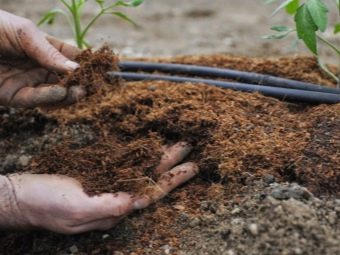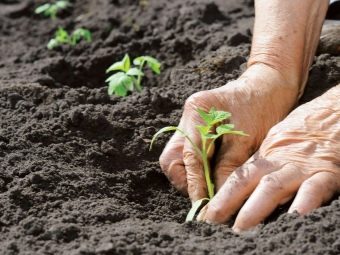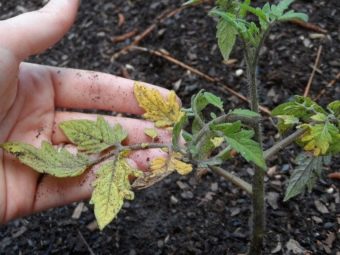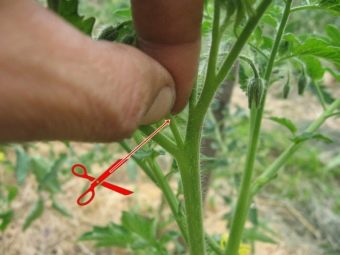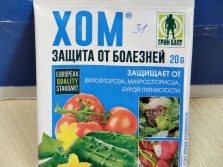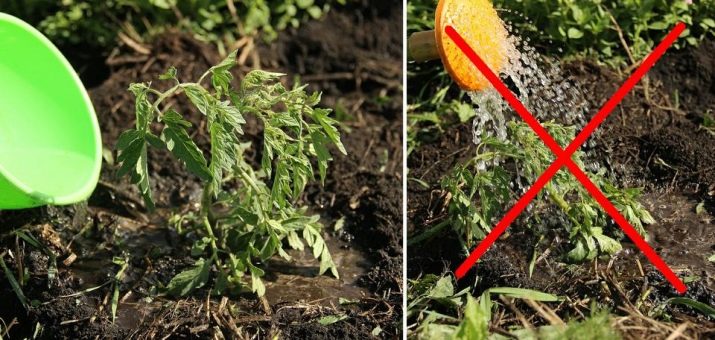Why do tomatoes turn yellow in a greenhouse?
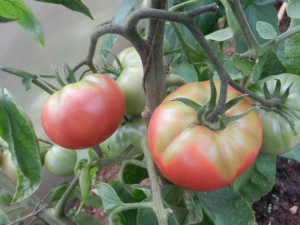
Tomatoes on our domestic beds came from southern countries, so their cultivation must be accompanied by a sufficient amount of light, heat and watering.In our climate, to provide suitable conditions for the cultivation of tomato, establish greenhouses. However, gardeners often face a number of problems, such as the appearance of pathogenic bacteria, a small crop, or poor germination, but most of all people are concerned that tomatoes grow yellow in greenhouse conditions.
The causes of yellowing are many, and the consequences can lead to a sad result.
Main reasons
If you begin to notice that yellowness appears on the lower leaves of the tomato and the plant begins to wilt, need to establish the cause of this phenomenon.
- Non-compliance with watering. Tomatoes are equally dangerous as excessive watering, and insufficient moisture. If the soil begins to dry, the plant should be watered moderately. When the irrigation regime becomes optimal and regular, and the earth is loosened, the tomatoes will quickly assume their original condition.
- The emergence of diseases. The leaves on the plant may become yellow if the plant was affected by fusarium wilt. To save your crop, you need to determine in time the presence of the disease and immediately begin to eliminate it.
- Tomatoes need minerals and trace elements. This is one of the most common reasons. The appearance of yellowing on the plant can mean that tomatoes only require additional feeding. It is especially important to use complex nitrogen fertilizer when the ripening period comes.
- The plant was damaged root system. This problem manifests itself in different situations. Tomato roots can eat pests, as well as the root system can damage the gardener himself in the process of transplanting seedlings in a greenhouse or during loosening. If there was damage of a mechanical nature, the plant will begin to spend all its strength on the restoration and the formation of additional roots. As soon as the roots are restored, the tomatoes will regain their original state, and the yellowness will disappear. In the event that pests become the cause, then they must be fought.
- Increased moisture content in the greenhouse. The optimum moisture level for tomatoes is 60%. If it is higher, the leaves will gradually turn yellow and rot. In the same way, a low moisture index also affects the plant.
Care errors
Very often, the tomato begins to turn yellow due to improper care of him. For example, a dried soil can be the answer to the question of why the leaves have turned yellow. In this case, you will need to eliminate every damaged part of the plant, adjust the irrigation regime and carry out the treatment with the help of a fungicide. A negative effect on tomatoes and excessive watering, it can also lead to a similar problem. Experienced gardeners know that tomatoes are better able to tolerate a little dryness than the bay. It is equally important to remember to air the greenhouse.
Very often, tomatoes start to hurt due to the fact that they were planted early in the ground. If this was done during a period of sharp changes in the temperature index, then the plant will lag behind in growth, as well as in development. In addition, the leaves will eventually begin to turn yellow with blue.
Few are aware of the fact that in conditions of low temperatures it is impossible to do fertilizing, as this will lead to a negative result.
If you notice that the leafy plates of the tomato turn yellow, but the veins remain green in color, this is the first sign that the plant lacks nutritional components. In this situation, the gardener needs to determine which element of the seedlings is not enough and in the shortest possible time to bring it into the soil. It is possible to determine which trace elements will need to be added to the soil using the following features:
- if the plant lacks nitrogen, the leaves of the tomato, which are below, begin to turn yellow, and the plant itself looks weak at the same time, the stems become small and thin; complex nitrogen-containing fertilizer will help to solve the problem;
- the appearance of small white dots that are increasing indicates that there is practically no potassium in the soil;
- if you notice that young seedlings begin to lose color, and after it, the old one acquires the same shade, then it means that there is not enough manganese in the ground (this happens because of the large amount of lime that is applied during fertilizer);
- marble color tomato leaves can be purchased in the absence of an element such as iron.
If necessary, restore the rate of one of the above elements, you can use a simple method. It will be necessary to add slurry and ash to the soil in a ratio of 1:10. Those who have already encountered similar problems recommend not using land from a vegetable garden or humus for seedlings, the best option would be forest soil.
If we talk about the ideal choice, then they can become the soil, which is collected from the maple.
Increasingly, inexperienced gardeners face another problem. Tomatoes do not shed their green mass, but on the contrary, they increase it, while the fruits are not tied. The reason for this phenomenon is the excessive nutritional value of the substrate. In addition, it is the substrate that can affect the fact that tomatoes will not only have to stick, but also to prune leaves.
Although for tomatoes, the conditions in the polycarbonate greenhouse are more comfortable than when grown in open ground, it is better to choose specimens for planting, which are distinguished by their strength and endurance.
Diseases and pests
Much depends on the selected planting material, because even acquired seeds can have fungal diseases and infections, including fusarium wilt. After planting, the plant (namely, the lower leaves) will not only have a yellow color, but also look as if it had not been watered for a very long time. If the acquired seeds are suspicious, it is better to abandon them. Experienced gardeners recommend using only those seeds that were collected by themselves.
As for diseases of tomatoes, the most dangerous can be called late blight. In this case, the trunk of the plant begins to become covered with brown spots, and the leaves and tops gradually turn yellow and dry. This disease is also spreading to the fruits. To prevent late blight, you must:
- irrigate only under the root;
- use drugs such as "Home", "Fitosporin";
- if the plant is sick, then the soil under the plant should be watered with a solution of manganese;
- Tomato bushes themselves will need to be processed using Bordeaux mixture.
Often tangible damage to tomatoes can be caused by insects, which lead to the fact that the leaves turn yellow in tomatoes. For example, the bear and the wire are very fond of eating the roots of a plant. Get rid of medvedki can help such a tool as "Thunder." As for the fight with the wireworm, here it is necessary to use the drug "Basudin" around the bushes.
Those who have been growing tomatoes for many years are advised to pay attention to the seeds they have acquired, and you should also disinfect the seeds with a solution of manganese. In addition, we should not forget about the disinfection of the tanks in which the seedlings will be located (this is done before the sowing).
Recommendations
To understand the reason for the appearance of yellowness on the leaves of tomatoes, you need to carefully examine the appearance of the plant. If you evaluate all the indicators, you can determine what the problem is. Do not forget about the basic recommendations for the care of seedlings:
- follow the rules of the content;
- water the plant regularly and correctly;
- spend timely feeding.
Only if the care is correct, tomatoes will be able to cope with most diseases themselves, resist pests and bring you a good and tasty harvest.
For information on how to identify and distinguish tomato diseases, see the following video.

